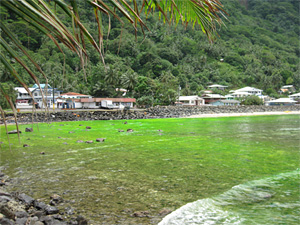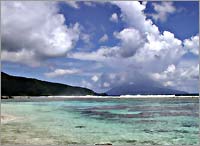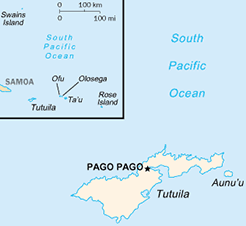Pacific Southwest, Region 9
Serving: Arizona, California, Hawaii, Nevada, Pacific Islands, Tribal Nations
Territory of American Samoa
EPA Response to American Samoa Tsunami Damage

Bay east of Pago Pago, colored by
spilled marine marker dye
EPA personnel were in American Samoa since shortly after the tsunami hit the island on September 29 2009, assessing the environmental impacts of the five tsunami waves and multiple earthquake aftershocks. Working with FEMA, the Coast Guard, the Hawaii National Guard, the American Samoa EPA and other agencies, EPA helped to clean up household hazardous waste, waste oil and other hazardous materials washed into the environment by the tsunami.
A staging area was set up to assist with collecting and disposing of paint, pesticides and other household chemicals. In addition, oil and diesel spills in Pago Pago, the area hardest hit, were contained and cleaned up. Orphan drums were also collected from the area.
Photo Gallery of Cleanup Activities
Map of Tsunami Inundation Area (PDF)
EPA On Scene Coordinator Information
FEMA American Samoa Response Web Site
EPA Response to Tsunami in American Samoa (FEMA Video)
Additional Resources
U.S.
Department of the Interior's Office of Insular Affairs Fact Sheet ![]()
On This Page
American Samoa is an unincorporated and unorganized territory of the United States, and administered by the U.S. Department of Interior. It consists principally of five volcanic islands and two coral atolls, for a total area of 76 square miles. It is located approximately 2,300 miles southwest of Hawaii. The largest and most populated island is Tutuila, on which are located the territory's historic capital (Pago Pago), and the seat of the legislature, judiciary, and the office of the Governor.
Along with Tutuila, the principal islands are Aunu'u and the Manu'a islands (a cluster of three islands, Ta'u, Ofu and Olosega, located about 65 miles east of Tutuila). Swains Island, a small island with a population of less than 25 and Rose Atoll, an uninhabited atoll about 120 miles east of Tutuila, make up the remainder of the territory. The population of the territory is approximately 65,000, of which about 97% live on the island of Tutuila.
The per capita income of American Samoa is only $8000, by far the lowest in the United States. American Samoa faces significant environmental and public health challenges:
- Almost 10% of residents do not have adequate indoor plumbing (piped water, a toilet or both)
- 17% had tested positive for leptospirosis, a serious waterborne disease associated with improperly managed pig waste.
- Heavy metals and other toxics in the inner portion of Pago Pago Harbor make fish unsafe to eat.
U.S. EPA works in partnership with the 20 staff of American Samoa Environmental Protection Agency.
Improvements
American Samoa has made great strides in battling the waterborne disease leptospirosis by significantly reducing the amount of waste from small pig farms going into streams. Using funds provided by EPA, American Samoa's "Team Lepto" has conducted over 130 inspections of small pig farms, or piggeries, many of which were located on streams. The team closed 62 non-compliant piggeries, and has worked with 51 owners to bring their pig farms into compliance with local regulations. As a result, "Team Lepto" has reduced nutrient loading from pig waste into the territory's waters by 16,000 pounds, protecting public health and nearby coral reefs. In one watershed alone bacterial contamination was reduced by over 90 percent. In addition, American Samoa is pioneering the use of alternative, sustainable pig farming in cooperation with regional universities and local pig owners to either entirely eliminate wet pig waste, or to compost the waste for use as fertilizer. American Samoa has become a model for pig management among other islands in the Pacific and Caribbean.
Lastly, in 2010 American Samoa became the first state or territory in the U.S. to ban plastic bags. This ban will help protect marine life such as turtles, fish, and coral reefs, which are harmed by marine debris such as plastic bags.

Additional Resources
- U.S. Department of the Interior's Office of Insular Affairs Fact Sheet

- American Samoa Environmental Protection Agency

Contact
Michael Wolfram (wolfram.michael@epa.gov)
American Samoa Program Manager
(415) 972-3027

